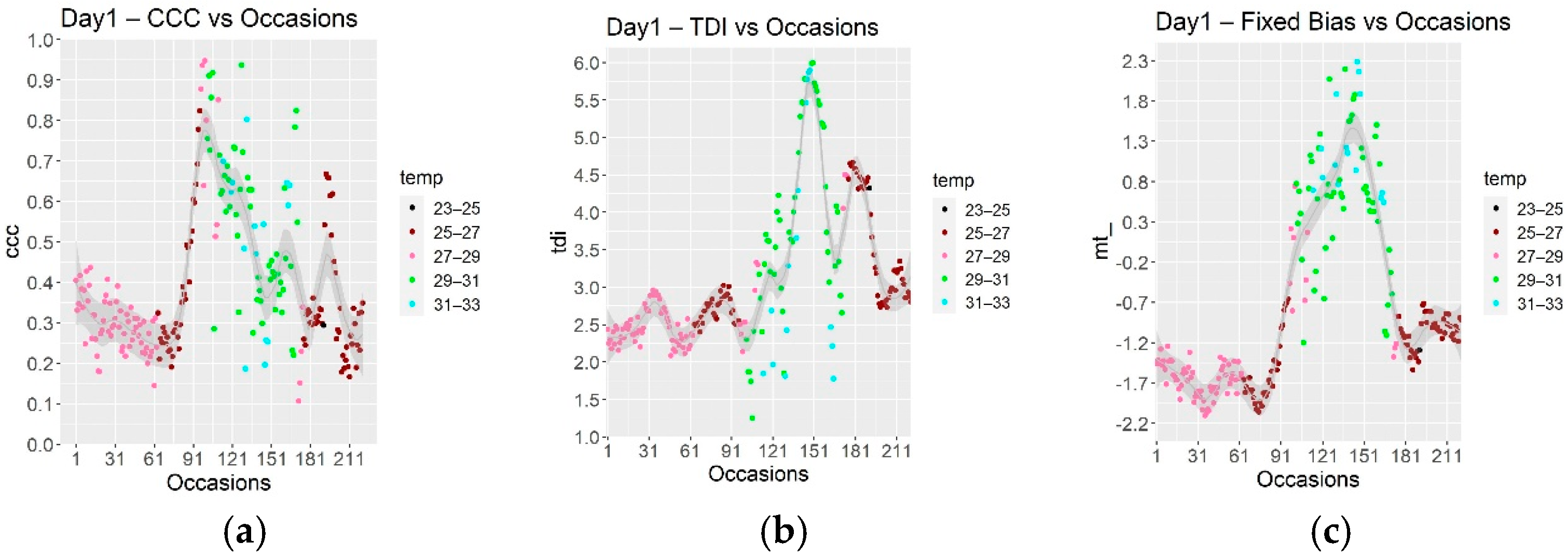A Method Comparison Study between Open Source and Industrial Weather Stations †
Abstract
:1. Introduction
2. Materials and Methods
2.1. Open-Source Weather Station
2.2. Industrial Weather Station
2.3. Experimental Design
2.4. Method Comparison Strategy
3. Results
Visual Representation of the Results
4. Discussion
Supplementary Materials
Author Contributions
Funding
Institutional Review Board Statement
Informed Consent Statement
Data Availability Statement
Conflicts of Interest
References
- Introduction to the Open-Source Philosophy and the Benefits of Sharing. Available online: https://www.academia.edu/44461841/Introduction_to_the_Open_Source_Philosophy_and_The_Benefits_of_Sharing (accessed on 20 March 2021).
- Community and Collaboration Open-Source Initiative. Available online: https://opensource.org/community (accessed on 19 April 2021).
- Tractenberg, R.E.; Jonklaas, J.; Soldin, S.J. Agreement of immunoassay and tandem mass spectrometry in the analysis of cortisol and free t4: Interpretation and implications for clinicians. Int. J. Anal. Chem. 2010, 2010, 234808. [Google Scholar] [CrossRef] [PubMed] [Green Version]
- Zaki, R.; Bulgiba, A.; Ismail, N.A. Testing the agreement of medical instruments: Overestimation of bias in the Bland-Altman analysis. Prev. Med. 2013, 57, 80–82. [Google Scholar] [CrossRef] [PubMed]
- Bataka, E.P.; Rodovitis, V.G.; Zarpas, K.D.; Papadopoulos, N.T.; Nakas, C.T. FruiTemp: Design, Implementation and Analysis for an Open-Source Temperature Logger Applied to Fruit Fly Host Experimentation. Appl. Sci. 2021, 11, 6003. [Google Scholar] [CrossRef]
- Fisher, D.K.; Fletcher, R.S.; Anapalli, S.S. Evolving Open-Source Technologies Offer Options for Remote Sensing and Monitoring in Agriculture. AIT 2010, 10, 1–10. [Google Scholar] [CrossRef] [Green Version]
- Martinez, J.; Egea, G.; Aguera, J.; Perez-Ruiz, M. A cost-effective canopy temperature measurement system for precision agriculture: A case study on sugar beet. Precis. Agric. 2017, 18, 95–110. [Google Scholar] [CrossRef]
- Altman, D.G.; Bland, J.M. Measurement in medicine: The analysis of method comparison studies. J. R. Stat. Soc. 1983, 32, 307–317. [Google Scholar] [CrossRef]
- Adafruit IO Basics. Available online: https://learn.adafruit.com/series/adafruit-io-basics (accessed on 1 February 2021).
- Arduino IDE. Available online: https://www.arduino.cc/en/software. (accessed on 25 July 2001).
- Thygro SDI-12 Temperature and Humidity Sensor. Available online: https://symmetron.gr/uploads/ThygroSDI-12Brochure_EN.pdf (accessed on 24 May 2021).
- Choudhary, P.K.; Nagaraja, H.N. Measuring Agreement, 1st ed.; Wiley: Hoboken, NJ, USA, 2017; pp. 1–251. [Google Scholar]
- Lin, L.; Hedayat, A.S.; Wu, W. Statistical Tools for Measuring Agreement, 1st ed.; Springer: New York, NY, USA, 2012; pp. 1–160. [Google Scholar]

Publisher’s Note: MDPI stays neutral with regard to jurisdictional claims in published maps and institutional affiliations. |
© 2021 by the authors. Licensee MDPI, Basel, Switzerland. This article is an open access article distributed under the terms and conditions of the Creative Commons Attribution (CC BY) license (https://creativecommons.org/licenses/by/4.0/).
Share and Cite
Bataka, E.P.; Miliokas, G.; Katsoulas, N.; Nakas, C.T. A Method Comparison Study between Open Source and Industrial Weather Stations. Eng. Proc. 2021, 9, 8. https://doi.org/10.3390/engproc2021009008
Bataka EP, Miliokas G, Katsoulas N, Nakas CT. A Method Comparison Study between Open Source and Industrial Weather Stations. Engineering Proceedings. 2021; 9(1):8. https://doi.org/10.3390/engproc2021009008
Chicago/Turabian StyleBataka, Evmorfia P., Georgios Miliokas, Nikolaos Katsoulas, and Christos T. Nakas. 2021. "A Method Comparison Study between Open Source and Industrial Weather Stations" Engineering Proceedings 9, no. 1: 8. https://doi.org/10.3390/engproc2021009008
APA StyleBataka, E. P., Miliokas, G., Katsoulas, N., & Nakas, C. T. (2021). A Method Comparison Study between Open Source and Industrial Weather Stations. Engineering Proceedings, 9(1), 8. https://doi.org/10.3390/engproc2021009008







